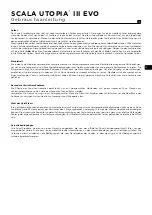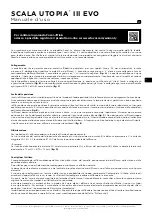
15
SCALA UTOPIA
®
III EVO
U s e r m a n u a l
Please validate your Focal-JMlab warranty,
it is now possible to register your product online: www.focal.com/warranty
Thank you for purchasing a Focal product. Welcome to our High-Fidelity world. Innovation, tradition, excellence and pleasure
are our values; our one and only aim is to bring you a sound that is rich, pure and true. To get the most out of your product, we
recommend that you read the instructions in this booklet, then store it in a safe place to refer to in the future.
Connections
Scala connectors provide reliable, multi-purpose contacts for stripped cables (up to 3,5mm diameter), fork terminals or
banana connectors. It is imperative to respect the connector polarity of both the loudspeaker and the amplifier. The connector
marked “+’’ must be connected to the positive output on the amplifier and the connector marked “-’’ must be connected to
the negative terminal (
fig. A
). Stereo image and bass perception would be seriously compromised if these conditions are not
respected. Choose good quality cables with a cross-section appropriate to their length: your retailer will be able to advise you.
Scala Utopia Evo can be connected via mono-amping, in which case, the ‘’straps’’ provided should be connected as indicated
(
fig. B
), or via bi-wiring/bi-amplification, in which case, the ‘’straps’’ should be removed, and each cable or amplifier should be
connected to the BASS and MAIN inputs as indicated (
fig. C
).
Positioning
These loudspeakers have been designed to deliver the most faithful reproduction of all kinds of music or home cinema programmes.
Nonetheless, we recommend following these simple rules to optimise their performance and to guarantee good tonal balance and
a realistic sound image.
The loudspeakers should be positioned symmetrically, facing the listening area,
ideally forming an equilateral triangle with it.
However, these distances may be adjusted to find the ideal compromise according to the design of your interior (
fig. B
).
The loudspeakers should be positioned at the same height, in the same horizontal plane.
Ideally, the tweeter should be positioned
at the same height as the listener’s ears in the usual listening position (
fig. C
).
Do not position your loudspeakers too close to a corner of the room and do not place them too close to a wall.
This will induce
some unwanted room resonance and artificially increase bass response. On the other hand, if the bass level is considered to be
insufficient, you could try moving the loudspeakers nearer a wall to re-balance the bass level (
fig. D
).
Optimisation
For perfectionists, here is a formula for optimal positioning:
If A is the distance from the centre of the woofer to the nearest floor or wall, B is the distance to the next closest floor or wall, and
C is the greatest distance (A < B < C), the equation B
2
= AC defines the ideal loudspeaker position.
• Example:
If the centre of the woofer is 20" (50cm) away from the rear wall (A) and 24" (60cm) above the floor (B), then the side wall will
be ideally 28" (72cm) away [C = B
2
/A = 28" (72cm)] (
fig. E
).
Recommendations for use
The behaviour of the loudspeakers depends on the acoustics of the listening room, on the correct positioning of the loudspeakers
within the room, and on the position of the listener.
It is possible to tweak each of these parameters to obtain or improve a desired effect.
Stereo perception is imprecise and poorly centred:
try moving the loudspeakers closer together and/or have them facing the
listening point.
The sound is harsh, aggressive:
the acoustics of your listening room are probably too reverberant. Consider using sound-absorbing
materials (carpets, upholstered furniture, tapestries, curtains, etc.) and sound-reflecting materials (furniture) to absorb or diffuse
resonance.
The sound is “flat’’, strangled:
there are too many sound-absorbing materials in the room, the sound is soaked up, it has no relief.
Look for the best compromise between sound-absorbing and sound-reflecting materials in your room.
In general, aim to have a reflective wall behind the loudspeakers for the sound to develop correctly. The wall behind the listening
area, on the other hand, should ideally be sound-absorbing to avoid rear reflections “contaminating’’ the stereo image.
Furniture can be judiciously placed near the side walls of the room to diffuse sound waves and ensure certain frequency ranges
are not excited, particularly in the midrange (suppression of flutter echoes).
Our policy of continual product improvement means that Focal-JMlab reserves the right to modify the technical specifications
of its products without notice. Product may vary from images.
Summary of Contents for SCALA UTOPIA III EVO
Page 2: ......
Page 4: ...4 SCALA UTOPIA III EVO Man u el d utilisation User manual G F H ...
Page 51: ......
















































